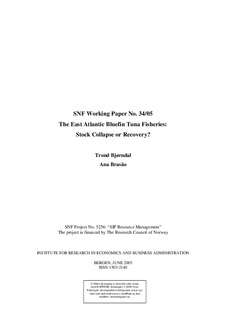| dc.description.abstract | In this paper, a discrete time, multi-gear and age structured bio-economic model is developed for the East Atlantic Bluefin Tuna fisheries, a paradigmatic example of the difficulties faced in managing highly migratory fish stocks. The model is used to analyse alternative management strategies for the Regional Fisheries Management Organisation managing this fishery, and to investigate some of the policy implications. For the various scenarios, the optimal stock level varies between roughly 500 – 800,000 tonnes, which compares with a stock level of 150,000 tonnes in 1995. In other words, there is a very strong case for rebuilding the stock. Moreover, the sustainability of the stock is threatened unless a recovery programme is implemented; indeed, the alternative may be stock collapse. Second, to rebuild the stock, draconian measures are called for: either outright moratoria over fairly lengthy periods, or possibly a more gradual approach to steady state given by a TAC at a low level for an extended period of time. Third, the cost of inefficient gear structure is very high indeed. | en |
